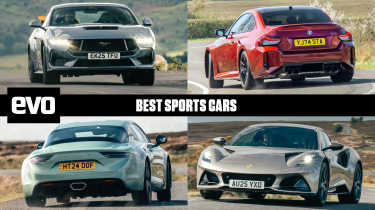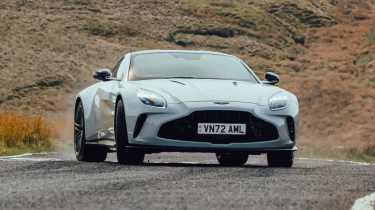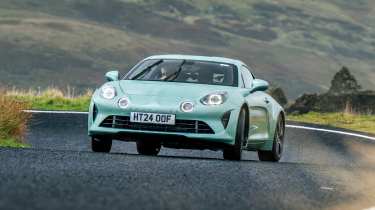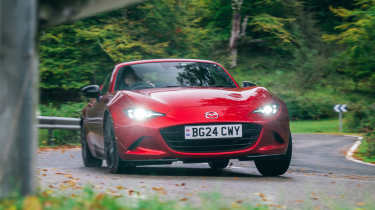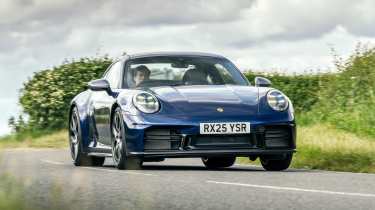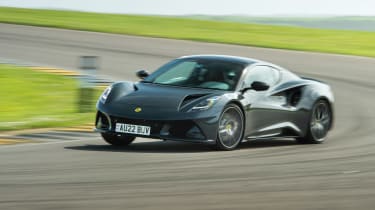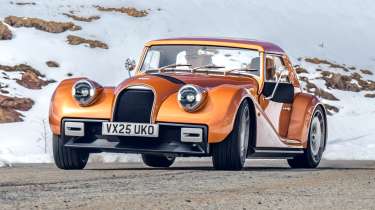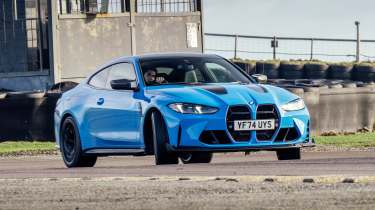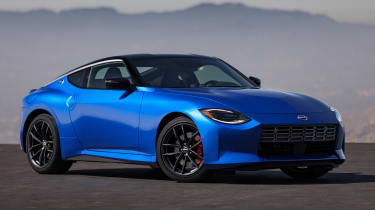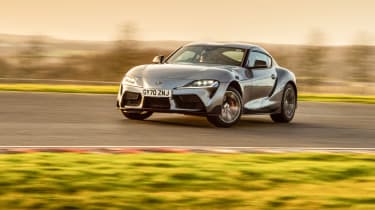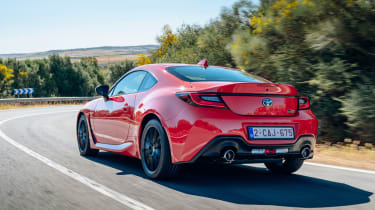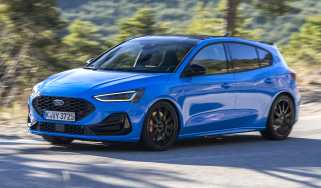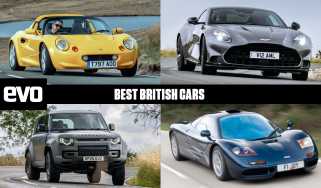Best sports cars 2025 – the last true driver’s cars
Sports cars are designed to do one thing above all else: put the driver at the centre of the experience. Morgan’s Supersport is the latest of the breed
Few motoring genres offer so much variety in terms of layout as the sports car. They can feature any number of different engine types in different positions, cylinder counts, natural aspiration or forced induction, manual or automatic gearboxes, two- or four-wheel drive… Power can be less than 200bhp, or over 600bhp. But while they come in many forms, all have one thing in common: a sports car’s raison d’être is to make you, the driver, the most integral part of the driving experience. This gives these cars intense focus – they need to be capable but above all else, entertaining.
In its rawest form, a sports car can be incredibly sparse yet also comfortable; the best manage to be accessible and amenable while still offering the purity of driver involvement and character that underpin the thrill of driving. Here, we pick our favourite sports cars currently on sale.
Best sports cars of 2025
- Porsche 718 Cayman and Boxster
- Alpine A110
- Aston Martin Vantage
- Mazda MX-5
- Porsche 911 Carrera T
- Lotus Emira
- Ford Mustang GT
- Morgan Supersport
- Mercedes-AMG GT
- BMW M4 CS
- BMW M2
Porsche 718 Cayman and Boxster
Although it might have gained a noise-restricting particulate filter and a few kilos of weight, the latest 718 Cayman and Boxster, especially in six-cylinder forms, is still a stunning example of what might be considered sports car nirvana.
While the astonishingly visceral GT4 RS and Spyder RS sit at the pinnacle of the range with a GT3-derived 493bhp motor and extreme aero, it's the softer and less wearing GT4 and Spyder that we enjoy most on the road. The engine is Porsche’s naturally aspirated 4-litre flat-six, putting out 414bhp and 310lb ft of torque to the rear wheels through the six-speed manual or seven-speed PDK. Both are the best examples of their type, although the manual does come with achingly long ratios.
Lesser models have nearly as much capability, with the GTS 4.0 losing some of the GT4’s and Spyder’s edge, but replacing it with an even more approachable demeanour – not to mention price point. Of course, if you’re less bothered about a resonant flat-six there are the four-cylinder models, and while they are a little flat (no pun intended) they’re also torquey and, especially in 2.5-litre S form, perform extremely well.
‘You feel you always have time to respond and react to whatever the road throws at you. And its soaring flat-six powerplant is endlessly inspiring. It’s a big engine for a small car but somehow it doesn’t feel inappropriate in the Boxster, which has the dynamic bandwidth to absorb the extra power and weight.’ – James Taylor, evo deputy editor, who tested the 718 GTS against rivals on the road in the UK.
Alternatives to the Porsche 718 Cayman and Boxster
Few to no rivals match the 718 Cayman on every front – it’s the consummate all-rounder. But many bring party tricks that make them arguably more appealing. The Alpine A110 falls short in terms of its interior quality but in every other way, is a heartwarming, life-affirming driver’s car. The BMW M2 doesn’t have the poise or precision of the Porsche and is a bit porky, but is far better for playing the tyre-flaying yob.
Aston Martin Vantage
If the landscape of lower-end sports cars is looking a bit barren in 2025, the higher end, where sports car meets supercar, is booming. The new Aston Martin Vantage is the poster child for this. The 153bhp power bump over the car it replaced might be the big headline, but it’s how the new Vantage feels that earns it a place as one of the best (super) sports cars you can buy right now. Yes, 656bhp is a lot for a sports car but the Vantage isn’t sloppy with it. It harnesses it. With superb balance, a transparent dialogue through the steering and chassis, the potency is yours to wield to the extent you choose, the slightly shorter gear ratios informing the ease of power band exploration.
The lesser talked about but no less important facet of a good sports car is that it has to be usable and livable on the road. You don’t want to be tired of the thing before you get to the piece of road you had your eye on. Happily, the Vantage retains more than enough proper Aston grand touring DNA, with a revamped interior and no less ability to settle down than a DB12 (though the ride is a little choppy). Basically, it’s as fast as a low-end supercar, almost as engaging as the best sports cars and has most of the GT credentials of its siblings – all the second car you could ever need.
‘You could argue it has too much power; although it’s not unruly, it certainly doesn’t need more than its 656bhp. But its slightly overpowered, overtorqued nature is part of a hot-roddish, muscle-car-esque appeal. And with better feedback and nimbler handling than the bigger, vaguer feeling DB12, you can use more of that power and torque more of the time.’– James Taylor, evo deputy editor, who tested the Vantage against rivals on evo Car of the Year.
Alternatives to the Aston Martin Vantage
The Vantage is a proper jack of all trades and a master of most. It can play sports car, supercar or GT car and as such, you could count key rivals as everything from the Porsche 911, to the McLaren Artura, to the Maserati GranTurismo.
Alpine A110
The Alpine A110 was an outstanding first effort from the revived marque when it arrived back in 2018, receiving almost full marks in our review and coming just a few points short of the top spot in that year’s eCoty. Sitting in line with the likes of Porsche’s class-leading Cayman, but with a different driving experience thanks to a lower kerb weight and softer spring rates, it’s a distinctive and hugely entertaining machine.
Four distinct models now make up the range: the base car, the GT, the S and the track-focused R. All versions apart from the standard car share the same 296bhp variant of the 1.8-litre engine, but the GT matches this with a softer setup than the sharpened-up S. The A110 R goes in the opposite direction with a carbonfibre aero package and adjustable coilovers for track work. On top of this are a consistent range of special editions, often dipping into the Atelier programme for colour and trim inspirations. Yet beyond having fun on the configurator, the A110 is simply a brilliant sports car – one that makes you feel at the centre of it, which is the whole point.
> New Alpine A110 goes electric
‘Its light weight enables relatively soft suspension and it gets down the road in a uniquely fluid way. Depending how you drive the softly suspended Alpine, it can settle into default safe-ish, steady-state understeer, or it can be manipulated into attitude with weight transfer.’ – James Taylor, evo deputy editor, who tested the A110 against rivals on the road in the UK.
Alternatives to the Alpine A110
The Porsche 718 is the Alpine's core in-market rival but there are a number of cars from years gone by that trade on similar tenets to the A110, from the Lotus Elise to the Toyota GR86. If you want to stay new and go even simpler, the latest Mazda MX-5 is a boon. If you want a bit more polish and a premium feel to go with a deeply rewarding drive, the Cayman is the answer.
Mazda MX-5 MY25
Believers will rejoice and skeptics will laugh, but there’s no doubting that the newly-updated Mazda MX-5 offers some of the best bang for your buck as a driver’s car. The top-spec 2-litre four-cylinder engine is no more powerful, its dimensions and weight remain the same and its bodywork isn’t significantly different, but none of that matters.
What ties the new model together as a great driver’s car is a revised limited-slip diff and tweaked steering, to join the Bilstein dampers and bigger brakes the MX-5 has had for a little while. The result is the MX-5 debugged, with just enough in its dynamic repertoire to be taken seriously, without corrupting the purist ethos.
Fundamentally, being a manual, two-seat, open-top, naturally-aspirated, rear-wheel drive car in 2025 is enough of a novelty. Add in that it’s not far off 1000kg makes it positively alien in today’s market. That it’s brilliant to drive means you should genuinely short-list it. We did, putting it on the podium during eCoty 2024, alongside a McLaren…
> Mazda MX-5 review – Japan’s evergreen roadster punches above its weight
There’s as much joy in wringing out a slow car as there is tapping into the massive power reserves of a really potent one: keeping the revs singing, opening the throttle to full before the apex, doing everything you can to conserve momentum. And working away at the gearbox to do so.’ – James Taylor, evo deputy editor, who tested the MX-5 against rivals on evo Car of the Year.
Alternatives to the Mazda MX-5
So unique is the Mazda MX-5 in what it offers that it doesn’t really have any direct rivals, in terms of price point or concept. A used GR86 gets close, or a minty fresh Honda S2000. The Alpine A110 has a similar lightweight ethos trading on sensation over raw performance, but comes in at a much higher price.
Porsche 911 Carrera T
While it might seem predictable, the Porsche 911 is the universal sports car benchmark, still now in its latest 992.2 generation. What’s strange is that this is the first 911 where you’ll need one of the lesser-known editions in order to get a manual, if you can’t stretch to a GT3.
The Carrera T is the most focused 911 south of a GT3 happily, and is more tailored than ever to the job of being the ‘enthusiast’s 911’, wearing its analogue chops on its sleeve. But beyond the little window stickers and the walnut shift knob, the Carrera T is a real sweetheart of a car, with all the balance of a standard Carrera, with a bit more focus and interactivity, thanks to choice chassis upgrades such as rear-axle steering, lowered PASM suspension and retuned anti-roll bars.
If you want more power, there is of course, the 911 GTS T-Hybrid, which we’d say is the other pick of the new 911 range alongside the Carrera T. It shows the potential of an electrified 911 with performance that’s only just Turbo-lite.
> Porsche 911 Carrera T review
‘The T’s added rawness is well judged and gives it a genuine sports car feel where the 992 has sometimes been accused of being too grown up. It’s purer and more exploitable than an AMG GT, more communicative and finely tuned than an M4 CS.’ – Yousuf Ashraf, evo senior staff writer, who tested the 911 Carrrea T on the road in the UK.
Alternatives to the Porsche 911 Carrera T
The best alternative to a Porsche is often another Porsche, and we’d recommend any prospective Carrera T buyer take a look at how much used GT3 they could get for their money. Likewise there are sublime Cayman GT4s and Boxster Spyders out there for folding money less. In the current market? A Lotus Emira is a hair cheaper but a lot less car. It could be an interesting prospect if you fancy tinkering with and modifying it, though.
Lotus Emira
The first all-new Lotus in 15 years was always going to be a big thing, but has it been worth the wait? Initial impressions suggest that while there are a few rough edges to sort out, overall the Emira is a fabulous sports car.
On road, the Emira’s biggest asset is feel and flow, the chassis and steering portraying the very finest of detail about the road surface below. Its relatively soft suspension does mean there is some roll and pitch, even with the stiffer ‘Sport’ specification chassis, but like the best of Lotus’s efforts before this, it allows the body to breathe with challenging road surfaces. On track this manifests itself as a lack of control, though.
Yet it’s the supercharged V6 engine and the gearbox which represent its biggest weakness. While charismatic, the engine itself just isn’t as capable or exciting as a Porsche 718 GTS’s, and the transmission remains obstructive, rather than encouraging. The four-cylinder version is slightly sweeter, but the AMG-derived motor can feel gruff and coarse when extended.
‘The Emira isn’t an ultimate benchmark for precision, but it does have real elements of magic, particularly ‘in heave’, where the car rises on its suspension over crests. It’s superbly controlled over brows and yumps. There’s enormous traction, too, even with the stability systems switched off, and when they are active, they intervene so subtly you barely know they’re there.’ – – James Taylor, evo deputy editor, who tested the Emira against rivals on the road in the UK.
Alternatives to the Lotus Emira
The Emira is a charming, capable sports car but ultimately doesn’t have the finesse and polish of its rivals. Chief among them is the Porsche 718 GTS 4.0, with the Alpine A110 not far behind it. You could also count a manual BMW M2 as a viable alternative and even a V8 Ford Mustang, though both offer a different sort of thrill to a proper mid-engined sports car.
Ford Mustang GT
So broad is the definition of sports car that a pony car from across the pond counts itself as one. It’s right at the heavier, more crude end of the spectrum but it deserves enormous credit for keeping alive the kind of motoring stimuli that are by and large dying out, at least in the affordable echelons of enthusiast cars – a naturally-aspirated V8 engine, a proper six-speed manual transmission. Never before has the Mustang quite so effectively transcended the appeal of its own iconography with genuine talent.
Our money wouldn’t be on it getting anywhere near, let alone toppling, an A110 or a Cayman or Boxster for poise or control but it’s a car you can develop a flow with and stroke along at generous-enough pace, rowing at the steering and leaning on the chassis. Your mates in their Porsches might walk away across ground but you’ll be having just as much fun at a lower pace. The V8 and the looks are the Mustang things we know and celebrate. The fact it’s a 2+2 coupe with something of a boot, adds a less discussed dimension to its capability. You could grand tour in this car.
‘There’s a boat-like feel to the Mustang: it sits down at the rear under acceleration and the big bonnet lifts ahead of you. Climbing steep hills, you occasionally need to sit up in the seat to see past the nose, since there’s so much bonnet ahead of you. The MagneRide dampers’ firmest setting is a little harsh for these roads; Sport is the sweet spot. The Mustang is more a momentum car than point-and-squirt, and you can carry good speed. It’s fun alright.’ – James Taylor, evo deputy editor, who tested the M2 against rivals on the road in the UK.
Alternatives to the Ford Mustang GT
The BMW M2 is the chief rival to the Mustang, adding precision to an equally yobbish recipe, that’s perhaps a little shorter than the Mustang on character. There aren’t many other cars like it left, though there are a few left-hooker sixth-generation Chevrolet Camaros knocking around on the used market.
Morgan Supersport
Morgans are always the oddball of the sports car class and the new Supersport, in spite of it being the most versatile, contemporary we’ve yet seen, is no exception. But as we found with the Plus Four on eCoty 2024, foolish is the individual who counts a Morgan out. It doesn’t have quite the same level of polish, poise and togetherness of something like a Cayman GTS 4.0, but it charms in ways that only a Morgan can.
Like with the Plus Four, there’s the option of a Dynamic Handling Pack that includes 24-way adjustable Nitron dampers, which, unlike the Plus Four, will be available from the beginning. They allow you to tailor your Morgan to the roads you’re traversing, be they the smooth Spanish routes we first drove it on, or the more rutted roadways of the UK. Also worth a punt, in order to fulfil the Supersport’s potential as a sports car, will be the Drexler limited-slip differential, for increased rear-end pliability.
Fundamentally, the Supersport retains all of the heartening quirkiness and classic lovability you associate with the marque, while being much more accessible and dynamically accomplished than ever before.
‘Dive and squat are well contained, and when we do hit some bigger compressions and bumps at speed, there’s no sign of the suspension running out of travel. In fact, it feels like the chassis could handle more than the current 335bhp and 369lb ft. Which isn’t something you might necessarily have said about the old Plus Six, which could be a touch lairy at times.’ – James Taylor, evo deputy editor, who tested the Morgan Supersport on the road on the launch.
Alternatives to the Morgan Supersport
We don’t count the obvious Porsches as alternatives to the Morgan. They’re the opposite of esoteric and as such, will surely be lacking something for those interested in Malvern’s boutique machine. Look instead to the Lotus Emira and Alpine A110 – they’re a bit more serious to drive and certainly in the A110’s case, a fair bit more satisfying, for basically half the price.
Mercedes-AMG GT
On face value, the new Mercedes-AMG GT is more compromised than the last one. It's no longer a two-seater sports car, but a larger four-seater based on the SL – a car that came stone dead last at evo Car of the Year in 2022. And yet the new GT is being pitched squarely at the Porsche 911 and aims to be faster, more engaging and more practical than before. The building blocks seem incompatible with this, but somehow, Mercedes-AMG has pulled it off.
It starts with the engine. Mercedes' 4-litre twin-turbocharged V8 has been muffled slightly in this application (thank emissions rules for that), but it still generates 577bhp and 590lb ft in the top-spec GT 63. Thanks to four-wheel drive, the new GT makes better use of its power than before to sprint to 62mph in just 3.2sec, matching the previous Black Series model.
The engine is housed in a stiffer space frame chassis that uses a plethora of electronic systems – from rear-wheel steering to active anti-roll bars and hydraulically cross-linked dampers – to deliver precision and capability that is a match for the best in class. But there's breadth here too, as the GT can be dialled down to Comfort mode to deliver a cosseting, low-effort driving experience for every day use.
‘Where the new GT ups the ante over its predecessor is when you dial the modes up. Sport+ locks everything down, but rather than turning the chassis into a bobsled it adds precision and alertness. There’s more weight to the steering – more an attempt to suggest feel than anything else – but it suits the GT when you begin to hustle it along.’ – Stuart Gallagher, evo editor-in-chief, who tested the new AMG GT on the road.
Alternatives to the Mercedes-AMG GT
The AMG GT is an easily placable sports GT within the marketplace, with alternatives including the Porsche 911 and the Aston Martin Vantage. You could also take a BMW M4 CS as a more practical yet more hardcore option, for less cash too.
BMW M4 CS
A BMW with a CS badge on the boot lid always carries an enormous weight of expectation. Some of the very best modern sports coupes and supersaloons – such as the eCoty-winning M2 CS and M5 CS – carry the moniker, hitting the sweet spot between usability and unfiltered driving thrills like few other rivals.
The new M4 CS has the same meticulous attention to detail and sense of purpose as its forebears, turning the already brilliant M4 Competition into one of the most rewarding coupes on sale. Lighter wheels, a carbonfibre bonnet and carbon facia inside help cut 15kg from the M4 Competition's kerb weight, but the real magic is in the chassis setup. The springs are stiffer, the dampers returned and the anti-roll bar links uniball-jointed for sharper responses. Peak power from the 3-litre turbocharged straight-six is boosted to 542bhp, too.
The result is an exploitable, devastatingly fast sports car. On track and equipped with Michelin Cup 2 R tyres, the CS feels positive and keyed in, giving the driver confidence to carry massive speed and hassle 911 drivers. The brakes bite hard, it turns in sweetly and there's scope to play with its balance without scaring yourself silly. More time in it both on the road and track during eCoty 2024 revealed the M4 CS wasn’t quite the elevated machine compared with the standard car we’d hoped it would be, but it’s still a mighty thing and easily recommendable.
‘It’s like a slot car with magnets in the nose. It’s still involving, though: with peak torque spread from 2750 to 5950rpm, you can engage the rear under power too. This is a truly agile, exciting car to drive.’ – James Taylor, evo deputy editor, who tested the M4 CS on evo Car of the Year.
Alternatives to the BMW M4 CS
The M4 CS’s alternatives are less practical but in some ways more appealing as driver’s cars, with the Porsche 911 Carrera S and Mercedes-AMG GT the most prominent. There is also BMW’s own standard M4 which is more broadly talented than the CS, if less intense in the right moments and indeed, the M2, which uses a similar engine in a smaller package with a manual gearbox and rear-wheel drive.
BMW M2
BMW may have opted for a Mini-derived platform for the latest 1-series, but the 2-series remains a true BMW right through to its DNA. It borrows its CLAR architecture from the 4-series, and this forms a fantastic basis for the M2, now boosted to 473bhp.
The last M2 didn't quite hit the spot at launch by virtue of its unrefined, jumpy dynamics, but it evolved into an evo Car of the Year winner by the time the CS version landed in 2020. The latest G87 started off on the right foot, though, with an indulgent rear-drive chassis, a stellar powerplant and the option of a manual gearbox. It's shorter, stiffer and keener than the M3 and M4, and it feels every bit the junior M car we'd hoped for. The updated car didn’t bring a more hardcore Competition specification but then, it didn’t need ‘fixing’, like the original M2 did. As such, it remains a brilliant little sports coupe, now with more muscle and still with great balance and control.
‘Even in higher gears, it’s possible to adjust the car’s attitude with the throttle. I have a really enjoyable drive, savouring the M2’s relatively neutral balance, oodles of torque and excellent composure over yumps and crests.’ – James Taylor, evo deputy editor, who tested the M2 against rivals on the road in the UK.
Alternatives to the BMW M2
The Ford Mustang is probably the M2’s closest rival, though a used M4 offers an appealing, more grown-up alternative from within BMW’s own ranks. Look to the Porsche 718 GTS for a more precise but less practical sports car with its own six-cylinder sweetheart of an engine.
Recently departed and the one that got away
If you’re reading this list somewhere outside the UK and Europe, it’s likely you've noticed a cohort of Japanese coupes that are missing from this list. Toyota’s terrific two have been removed from sale and Nissan’s Z was never destined for European shores in the first place…
Nissan Z
Nissan’s new Z will remain forbidden fruit for a few reasons. New safety regulations cause some problems, as well as the emissions regs that its twin-turbocharged V6 has not been developed to pass.
Since its debut, the Z has proved to be an intriguing new part of Nissan’s global line-up, but the disappointing reality is that it will remain a conspicuous absence here. And with the demise of the GT-R in the UK it looks as if, for now, Nissan will put its sports cars to bed, with an eye to returning when technology will facilitate a move to electrification without obvious compromise. Given its struggles at the moment, relatively expensive cars that sell in lower volumes will be low on the priority list.
Toyota GR Supra
We’ve had a love-hate relationship with the GR Supra because it has often fallen short on account of its prickly handling and dull powertrains. It’s a shame it’s now seemingly off-sale though (off Toyota’s website at least), because, well, fewer sports cars is always a bad thing. Plus, Toyota was diligent in improving it, smoothing over its rough edges to help it become a much more interesting proposition.
The four-cylinder 2.0 version went some way to addressing the 3.0’s handling issues too, as a more balanced, more responsive and less snappy option. Things got even better with the launch of the six-speed manual for the 3.0 car – the over-torqued rear axle of the auto is now more settled and the handling limits now more approachable thanks to small changes to the suspension set-up and differential.
The manual transmission also plays the role of upping interaction, making it feel a little bit more like an old-school muscle car with overtones of sports car-like agility. It's not perfect, but the Supra only got better with age and adjustments.
> Toyota GR Supra review - Japan's sports car hero driven on road and track
Toyota GR86
If there was an ultimate template for a sports car, it might look a little something like the GR86, which makes the brevity of its presence in Toyota’s lineup all the more painful. This is a front-engined, rear-drive, two-door coupe with a six-speed manual transmission up front (an auto was optional, but why would you?) and a limited-slip differential out back. It’s a recipe that was defined by the previous GT86, but one refined and extrapolated on in this latest iteration.
This isn’t a numbers car; with only 231bhp on tap to motivate itself it’ll struggle to keep up with a well-driven Fiesta ST. Instead, this is all about balance and involvement – which is exactly our cup of tea. Every element of the GR86’s dynamic repertoire has been fettled, sharpened and refined, resulting in a fabulous sports car that operates with a quality beyond what you might expect from its power and price points.
But there was a catch, and that was how you got your hands on one. Only a very limited number of Toyota GR86s were available in the UK, all of which have been spoken for. The limited supply is thanks to a European safety regulations rule change that means the GR86 will become non-homologated for our consumption – both a shame, but also an opportunity for Toyota to start working on a new one.
